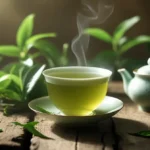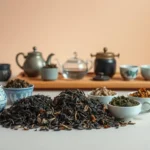Table of Contents
Are you curious about the health benefits of pu erh tea green or black and wondering which version is better for your well-being? You’re not alone. Pu Erh tea has become increasingly popular among tea lovers and health enthusiasts.
Pu Erh tea is known for its unique fermentation process. This sets it apart from other teas. Both green and black Pu Erh tea have different flavors and health benefits. In this article, we’ll look at the differences and help you choose the best for your health.
Key Takeaways
- Understanding the differences between green and black Pu Erh tea
- Exploring the unique health benefits of each type
- Discovering which type is more beneficial for your specific health needs
- Learning about the fermentation process and its impact on nutritional value
- Getting tips on how to incorporate Pu Erh tea into your daily routine
What Is Pu Erh Tea?

Pu Erh tea has a rich history and a unique way of being made. It’s a favorite among tea lovers. Let’s explore what makes it so special.
The Origins and History of Pu Erh Tea
Pu Erh tea comes from Yunnan Province in China. It has been made there for centuries. The tea was traded along the Tea Horse Road, an ancient path that connected Yunnan with other parts of China and beyond.
The way Pu Erh tea is made has changed over time. But, the old ways are kept alive today. People love it for its taste and health benefits.
Traditional Production Methods
Making Pu Erh tea is special because of its fermentation process. The leaves are first sun-dried, then piled together to undergo a natural fermentation process. This can take months to years, making the tea’s flavor and smell unique.
Making Pu Erh tea the old way is hard work. Tea makers watch the leaves closely to get the perfect taste.
Understanding Green Pu Erh Tea

Green Pu Erh tea is a special type of Pu Erh tea. It’s known for its unique processing and health benefits. Learning about green Pu Erh can make you appreciate this traditional Chinese tea more.
How Green Pu Erh Tea Is Processed
Green Pu Erh tea is made in a few key steps. First, the tea leaves are picked and then fixed by heating. This stops oxidation and keeps the tea’s antioxidants. It also makes green Pu Erh fresh.
After fixing, the leaves are rolled and dried. Unlike black Pu Erh, green Pu Erh doesn’t ferment or age. This keeps its green color and fresh taste.
Key Steps in Green Pu Erh Processing:
- Harvesting: Fresh tea leaves are plucked from the tea plants.
- Fixation: The leaves are heated to prevent oxidation.
- Rolling: The leaves are rolled to release any remaining moisture.
- Drying: The final step involves drying the leaves to preserve them for storage.
Flavor Profile and Characteristics
Green Pu Erh tea tastes fresh, earthy, and slightly sweet. Its minimal oxidation keeps its antioxidants. This makes it a smooth, mellow tea that’s less bitter.
| Characteristics | Description |
|---|---|
| Flavor Profile | Fresh, earthy, slightly sweet |
| Processing Method | Fixation, rolling, drying |
| Health Benefits | High in antioxidants, possible weight management benefits |
Exploring green Pu Erh tea is a delightful experience. Its unique processing and taste make it a must-try for tea lovers. Whether you’re new to Pu Erh tea or a seasoned enthusiast, green Pu Erh is worth trying.
👉 Grab Your Exclusive Pu Erh Tea Now For Superior Health 👈
Understanding Black Pu Erh Tea

Curious about black Pu Erh tea’s unique taste? It’s key to know its processing. Black Pu Erh, or ripe Pu Erh, has a special fermentation process. This sets it apart from other teas, like green ones.
How Black Pu Erh Tea Is Processed
Black Pu Erh tea starts with leaves from the Camellia sinensis plant. These leaves are then piled and fermented for months. This process breaks down the tea’s compounds, making it darker and milder.
Controlled fermentation is vital in making black Pu Erh. Unlike green Pu Erh, which ages naturally, black Pu Erh ferments to speed up aging. This makes it drinkable sooner than green Pu Erh.
Flavor Profile and Characteristics
Black Pu Erh tea tastes earthy and mellow, smooth and rich. Its fermentation gives it a complex, soothing flavor. Unlike other teas, it’s not astringent, with a velvety texture and no bitterness.
Brewing black Pu Erh tea yields a deep, reddish-brown liquor that looks great. Its aroma is earthy, with wood and sweetness hints. This makes it a top choice for those who love a strong yet smooth tea.
Pu Erh Tea Green or Black: Key Differences

Exploring Pu Erh tea reveals green and black varieties with unique differences. These differences can greatly enhance your tea experience. Knowing these differences helps you choose the right type for you.
Processing and Fermentation Differences
Green and black Pu Erh teas are processed differently. Green Pu Erh leaves are minimally oxidized, keeping their antioxidants and fresh taste. Black Pu Erh, on the other hand, goes through fermentation, changing its flavor and nutritional value.
This processing difference impacts taste and health benefits. For example, black Pu Erh’s fermentation can boost its digestive health benefits.
Aging and Storage
Both green and black Pu Erh teas age well, but need different storage. Green Pu Erh is best enjoyed fresh, as it can lose flavor over time. Black Pu Erh, like fine wine, matures with age and can be stored longer.
Storing both types in a cool, dry place, away from sunlight, is key. As a Pu Erh enthusiast said, “
Pu Erh tea is like a living entity; it evolves and improves with age, but only if stored correctly.
Caffeine Content Comparison
Green Pu Erh tea has less caffeine than black Pu Erh. This is because fermentation breaks down some caffeine in black Pu Erh, but the difference is not huge.
If caffeine sensitivity is a concern, green Pu Erh is better. For a gentle energy boost, black Pu Erh might be more fitting. Here are some key points to consider:
- Green Pu Erh tea: Lower caffeine content, fresher taste
- Black Pu Erh tea: Higher caffeine content, earthier flavor
👉 Unlock The Proven Health Perks Of Top Pu Erh Tea 👈
Health Benefits of Green Pu Erh Tea

Green Pu Erh tea is not just tasty but also packed with antioxidants and other good stuff. Drinking it daily can bring many health perks that boost your overall health.
Antioxidant Properties and Free Radical Protection
Green Pu Erh tea is full of antioxidants. These are key in fighting off free radicals. Free radicals can harm cells and lead to chronic diseases. Drinking green Pu Erh tea helps protect your body from these harmful molecules.
The antioxidants in green Pu Erh tea also help reduce inflammation. This can improve your overall health. Adding it to your daily routine is a smart move for your health.
Weight Management and Metabolism Benefits
Green Pu Erh tea can help with weight management. It’s thought to boost your metabolism and help burn fat. Studies show that its catechins can regulate your metabolism, aiding in weight loss.
Drinking green Pu Erh tea can increase your metabolic rate. This supports a healthy weight management plan.
Blood Sugar Regulation
Green Pu Erh tea may also help control blood sugar levels. Research suggests it can improve glucose metabolism. This is good news for people with diabetes or prediabetes.
Health Benefits of Black Pu Erh Tea

Looking for a tea that boosts wellness? Black Pu Erh tea is a great pick. It’s been enjoyed for centuries for its taste and health perks.
Digestive Health and Gut Microbiome Benefits
Black Pu Erh tea is good for your digestive health. It helps keep your gut microbiome healthy. The fermentation process adds probiotics that aid digestion and ease digestive issues.
Drinking black Pu Erh tea helps keep your gut balanced. A healthy gut is key for your overall health and happiness. It also boosts your immune system and mental well-being.
Cholesterol-Lowering and Heart Health Effects
Studies show black Pu Erh tea is good for your heart health. It can lower cholesterol levels. The tea helps your body absorb less dietary cholesterol, improving your lipid profile.
Drinking black Pu Erh tea regularly may lower your heart disease risk. It’s a smart choice for a heart-healthy lifestyle.
Detoxification Properties
Black Pu Erh tea is also thought to have detoxification properties. It helps remove toxins from your body. The tea supports your body’s detox processes, boosting your health and well-being.
Adding black Pu Erh tea to your daily routine helps your body detox naturally. It keeps you healthy and feeling your best.
In summary, black Pu Erh tea is packed with health benefits. It supports digestive health, heart health, and detoxification. Drinking it daily can improve your overall well-being.
👉 Experience Elite Pu Erh Tea With Exclusive Flavors Today 👈
Comparing the Health Benefits: Green vs. Black Pu Erh
Green and black Pu Erh tea have caught a lot of attention for their health benefits. Each type has its own advantages, making them good for different health goals and tastes.
Which Is Better for Weight Loss and Metabolism?
Both green and black Pu Erh tea can help with weight loss and metabolism. Green Pu Erh tea might be better because it has more catechins, which can boost metabolism. But, black Pu Erh tea’s fermentation process can help with fat digestion and absorption.
A study showed that both green and black Pu Erh tea can aid in weight loss. The choice between them might depend on how your body reacts.
Which Has More Potent Antioxidant Effects?
Antioxidants are key in both green and black Pu Erh tea. Green Pu Erh tea has more catechins, which are strong antioxidants. Black Pu Erh tea, on the other hand, gets new antioxidants from fermentation, like theaflavins, which are also powerful.
Differences in Cardiovascular Benefits
Both teas are good for the heart, lowering cholesterol and improving heart health. Green Pu Erh tea’s antioxidants might offer more direct heart benefits. Black Pu Erh tea’s benefits could be more about its effect on gut health.
Matching Tea Type to Your Personal Health Goals
Choosing between green and black Pu Erh tea depends on your health goals. If you want more antioxidants and weight loss benefits, green Pu Erh might be better. For digestive health and heart benefits through gut health, black Pu Erh could be the choice.
| Health Benefit | Green Pu Erh Tea | Black Pu Erh Tea |
|---|---|---|
| Weight Loss | Higher catechin content may boost metabolism | Enhanced fat digestion and absorption |
| Antioxidant Effects | Higher catechin content | Presence of theaflavins due to fermentation |
| Cardiovascular Benefits | Direct benefits through antioxidant activity | Benefits through modulation of gut microbiota |
Knowing the health benefits of green and black Pu Erh tea helps you choose the right one for your health goals.
Potential Side Effects and Considerations

When you start drinking Pu Erh tea every day, think about the possible side effects. It’s usually safe, but it might not be good for everyone.
Caffeine Sensitivity and Sleep Considerations
Pu Erh tea has caffeine, which can affect people in different ways. If you’re sensitive to caffeine, you might feel jittery, anxious, or have an irregular heartbeat. Drinking it in the evening can mess up your sleep because of the caffeine. Try drinking it earlier in the day to keep your sleep good.
Digestive Reactions and Tolerance
Some people might get bloated or feel stomach discomfort from Pu Erh tea. This is because it’s fermented. If you’re trying Pu Erh tea for the first time, start with a little bit. You can then drink more as your body gets used to it.
Quality and Sourcing Importance
The quality and where Pu Erh tea comes from really matter. Look for trusted places that sell high-quality, organic Pu Erh tea. Avoid very cheap or dirty products because they might have harmful things like heavy metals.
| Consideration | Precaution |
|---|---|
| Caffeine Sensitivity | Monitor caffeine intake, avoid evening consumption |
| Digestive Issues | Start with small amounts, assess tolerance |
| Quality and Sourcing | Choose reputable, organic sources |
Conclusion: Choosing the Right Pu Erh Tea for Your Health Needs
Now you know the differences between green and black Pu Erh tea. You can pick the best one for your health goals. If you want antioxidants and help with weight, green Pu Erh might be for you. Black Pu Erh is great for digestion and a stronger taste.
When choosing Pu Erh tea, remember your caffeine sensitivity and taste preferences. The Pu Erh tea benefits are many, like better heart health and detox. Adding either green or black Pu Erh to your day can boost your health naturally.
👉 Taste The Certified Best Pu Erh Tea For Your Health 👈
FAQ
What is the main difference between green and black Pu Erh tea?
Green Pu Erh tea is minimally oxidized. Black Pu Erh tea goes through fermentation. This changes its flavor and nutritional profile.
How does the caffeine content compare between green and black Pu Erh tea?
Green Pu Erh tea has a bit more caffeine than black. But the difference is small. Both are good for those who are caffeine sensitive.
Are there any specific health benefits associated with consuming Pu Erh tea?
Yes, both green and black Pu Erh tea offer health benefits. These include antioxidants, weight management, and heart health. The benefits depend on the tea type and quality.
Can Pu Erh tea help with weight loss?
Some studies show Pu Erh tea, like green Pu Erh, may help with weight loss. It may boost metabolism and fat burning. But results can vary.
How should I store Pu Erh tea to preserve its quality?
Store Pu Erh tea in a cool, dry place. Keep it away from sunlight and moisture. Use an airtight container.
Is it safe to consume Pu Erh tea daily?
Most adults can safely drink Pu Erh tea in moderation. Be careful of caffeine intake. Also, watch for interactions with medications or health conditions.
Can I drink Pu Erh tea if I’m sensitive to caffeine?
If you’re caffeine sensitive, start with small amounts of Pu Erh tea. Watch how your body reacts. Both green and black Pu Erh have caffeine.
What is the ideal brewing method for Pu Erh tea?
Use hot water, not boiling, for brewing Pu Erh tea. Adjust the steeping time to your liking. Multiple infusions can enhance the flavor.




![Jasmine Tea vs Green Tea Benefits: Which Gives Better Health Results? [2025] jasmine tea vs green tea benefits](https://www.goteaworld.com/wp-content/uploads/2025/09/jasmine-tea-vs-green-tea-benefits-150x150.webp)

![Pu Erh Tea vs Green Tea: Which is Better for Daily Health? [2025] pu erh tea vs green tea](https://www.goteaworld.com/wp-content/uploads/2025/10/pu-erh-tea-vs-green-tea-150x150.webp)






